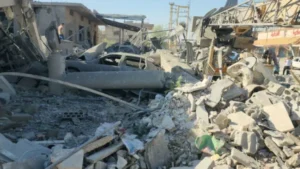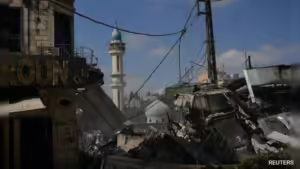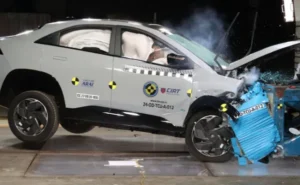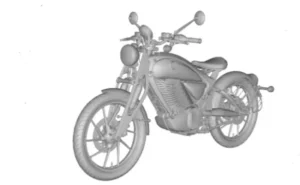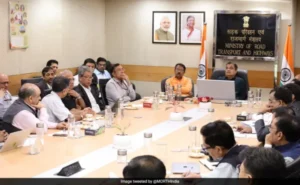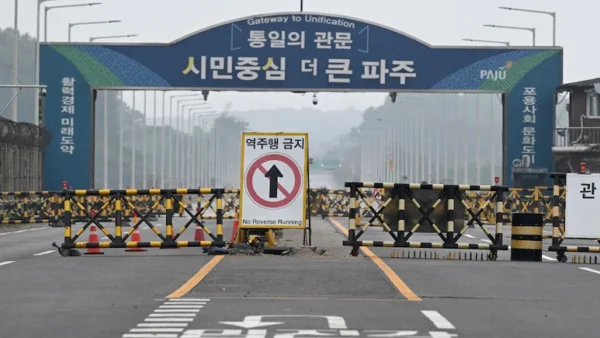
Barricades at a military checkpoint on the Tongil bridge, the road leading to North Korea's Kaesong city.
SEOUL: North Korea blew up parts of symbolic roads linking it to South Korea on Tuesday, Seoul’s military said, adding that it took “retaliatory measures” in response.
Pyongyang’s military last week vowed to permanently seal its southern border after spending months laying landmines and building anti-tank barriers after its leader Kim Jong Un declared South Korea his country’s “main enemy”.
Last week North Korea accused Seoul of using drones to drop anti-regime propaganda leaflets over the capital, Pyongyang, prompting Kim to call a security meeting to plan “immediate military action” in response, state media reported on Tuesday.
On Tuesday, the Joint Chiefs of Staff said “North Korea has blasted parts of the Gyeongui and Donghae roads north of the Military Demarcation Line,” referring to inter-Korean infrastructure that once linked the two countries.
“Our forces have not suffered any casualties, and our forces have returned fire in areas south of the MDL,” it added.
The roads have long been closed, but destroying them sends a clear message that Kim is not willing to negotiate with the South, experts said.
Yang Moo-jin, president of the University of North Korean Studies in Seoul, told AFP: “This is a practical military measure related to the hostile dual-state system that North Korea often refers to.”
Yang said North Korea is also looking to erect more physical barriers along the border, adding that the road blasts could be “preparatory work for building those walls.”
Drones?
Seoul’s military initially denied sending the drones to the North but later declined to comment on it, while Pyongyang has directly blamed them, warning it would consider it a “declaration of war” if another drone was captured.
Activist groups have long campaigned in the North, usually by balloon, and enthusiasts have also been known to fly small, hard-to-detect drones into the North.
According to enthusiasts who spoke to local media, unlike traditional drones made of metal, the devices they used were made of expanded polypropylene, similar to Styrofoam, allowing them to go undetected by both South and North Korean authorities.
At Kim’s meeting on Monday, officials heard a report on “serious provocations of the enemy”, KCNA said, adding that Kim “expressed a stern political and military stance”.
The North has said the United States, which has a military alliance with South Korea, should also be held responsible.
North Korea has itself sent drones to the South — in 2022, five of Pyongyang’s drones crossed the border, prompting the South Korean military to fire warning shots and deploy fighter jets.
The jets failed to shoot down any of the drones.
In July, Seoul said it would deploy drone-melting lasers this year, saying the South’s ability to respond to provocations would “significantly increase”.
The new laser weapons — called the “Starwars Project” by the South — shoot an invisible, silent beam that costs just 2,000 won ($1.45) per use, according to the Defense Acquisition Program Administration.
Relations between the two Koreas are at their lowest point in years, with the North’s military saying last week it would permanently close the southern border by “completely cutting off roads and railroads” linked to the South and building “strong defense structures.”
Following Kim’s meeting in Pyongyang, “attention has turned to whether North Korea will respond by sending drones into South Korea or take stronger action if drones intrude into its territory again”, said Cheong Seong-chang of the Sejong Institute.
“North Korea may take stronger provocations along the border if drone intrusions are repeated,” Cheong told AFP.

Continuing the achievement of the journey of effectiveness and credibility of more than 10 years in the career of journalism, as a woman journalist, I am Serving as the founder, promoter and editor of DiaryTimes with the trust and support of all. My credible coverage may not have given a big shape to the numbers, but my journey presents articles that make you aware of the exact and meaningful situations of Himachal’s politics, ground issues related to the public, business, tourism and the difficult geographical conditions of the state and financial awareness. DiaryTimes, full of the experience of my precise editorial expertise, is awakening the flame of credible journalism among all of you, so that the eternal flame of meaningful change can be lit in the life of the people of the state and the atrocities being committed against the people can be brought to the fore, I am motivated for that. If even a small change comes with the power of my journalism and the whole world becomes a witness to that issues, then I will consider myself fortunate.


